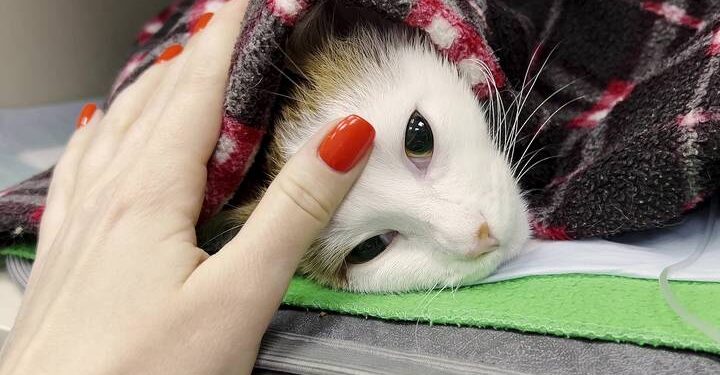How to Tell If Your Cat Has a Fever

Cats, like humans, can get sick and develop fevers. Monitoring your cat’s health and recognizing signs of fever is crucial for their well-being since an elevated body temperature usually indicates an underlying issue or infection.
Monitoring your cat’s health and identifying signs of fever is vital so you can promptly take care of any underlying issues or infections. By being aware of the signs and symptoms of fever, you can take the necessary steps to maintain your cat’s health and ensure their overall comfort and happiness.
The following are ways to tell if your cat has a fever so you can take appropriate steps to ensure their health and comfort.
1. Ears and Nose

Checking your cat’s ears and nose is one method for identifying potential signs of fever. Start by gently touching the cat’s ears—typically, a fever will make your ears feel warm or hot. Excessive warmth may indicate an elevated body temperature.
Similarly, feeling the nose can provide insight; if it feels dry and hotter than usual, it could be another indication of fever. These signs alone aren’t definitive, so consulting a veterinarian for proper evaluation and guidance is always advised if you suspect a fever.
2. Rectal Temperature

Taking your cat’s rectal temperature is the most accurate way to determine if they have a fever. Lubricate a digital thermometer with petroleum jelly. Gently lift the cat’s tail and insert the thermometer about an inch into the rectum.
Hold it for about a minute or until it beeps, indicating the reading is complete. Normal feline body temperature ranges from 100.4 to 102.5°F (38 to 39.2°C). A temperature higher than 102.5 degrees Fahrenheit (39.2 degrees Celsius) is a fever.
3. Lethargy

Lethargy in cats can be a telling sign of fever. The increased body temperature can make them feel weak, tired, and disinterested in their usual activities.
If you notice your cat has a marked lack of energy, aren’t moving around as much as usual, and have an overall subdued demeanour, they might have a fever. If lethargy lasts more than 24 hours, you should call a vet for advice.
4. Reduced Grooming

Cats are usually meticulous groomers, but their energy and motivation to groom diminish with a fever. Fever elevates their body temperature, making them feel sluggish and uncomfortable. Grooming, an essential part of a cat’s routine, becomes a strenuous task during this period.
The cat may be dishevelled, with an unkempt coat and potentially oily or dirty fur. Monitoring a cat’s grooming habits is vital to recognize signs of illness and seek appropriate veterinary care.
5. Loss of Appetite

Keeping a close eye on your cat’s appetite can provide valuable clues about their health, especially if you suspect they might have a fever. A significant change in appetite can be indicative of discomfort or illness. Fever can make food less appealing and cause pain when swallowing or chewing.
Cats, known for their selective eating habits, may show disinterest in their usual meals. Suppose you notice a major reduction in food consumption or complete disinterest in eating, especially if accompanied by other signs of illness like lethargy or hot ears and nose. In that case, it’s essential to consult a veterinarian.
6. Reduced Water Intake

Cats may reduce their water intake, potentially due to discomfort or a decreased sense of thirst caused by the fever. Reduced water intake in cats during a fever can escalate the severity of the situation.
Dehydration, a common consequence of decreased water consumption, can lead to additional stress on the cat’s organs and worsen the fever’s effects. If a cat exhibits signs of dehydration, prompt veterinary attention is essential to address the fever’s root cause, rehydrate the cat, and provide necessary medical intervention for a swift recovery.
7. Shivering or Trembling

When a cat has a fever, their body temperature is elevated, and shivering may occur as the body attempts to regulate it. If you notice your cat trembling or shivering, particularly if they are not in a cold environment or under stress, it’s a cause for concern.
Shivering might be accompanied by other signs of discomfort like lethargy, reduced appetite, or seeking warm places. Monitoring and promptly consulting a veterinarian if you observe these symptoms can aid in diagnosing and treating any underlying illness.
8. Rapid Breathing

Rapid breathing is a concerning symptom of fever in cats. When a cat has a fever, their body temperature rises due to an underlying infection or illness. Elevated body temperature prompts the cat to breathe faster to dissipate heat and regulate their internal environment.
This rapid breathing, or tachypnea, is an adaptive response to fever-induced physiological changes. It can be observed through visible chest movements and increased respiratory rate. If you notice your cat breathing rapidly, immediate veterinary attention is essential to diagnose and manage the fever and its underlying cause.


